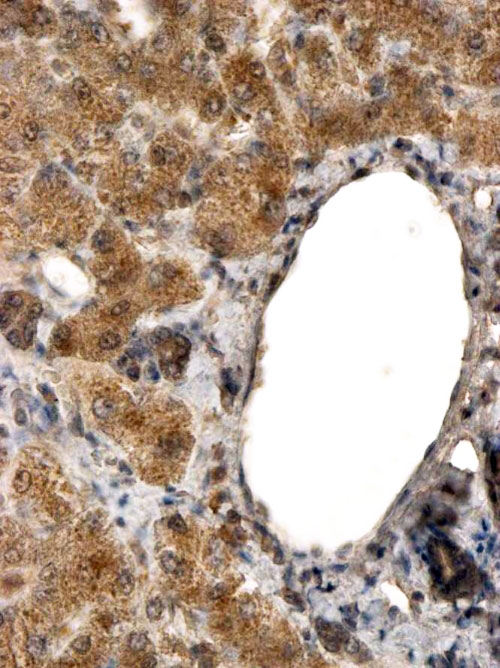Goat Anti-ALDH3A2 Antibody (internal region)
Purified Goat Polyclonal Antibody
- SPECIFICATION
- CITATIONS
- PROTOCOLS
- BACKGROUND

Application
| IHC, E |
|---|---|
| Primary Accession | P51648 |
| Other Accession | NP_001026976.1, NP_000373.1 |
| Reactivity | Human |
| Predicted | Human, Dog |
| Host | Goat |
| Clonality | Polyclonal |
| Concentration | 0.5 |
| Calculated MW | 54848 Da |
| Gene ID | 224 |
|---|---|
| Other Names | ALDH3A2; aldehyde dehydrogenase 3 family, member A2; ALDH10; DKFZp686E23276; FALDH; FLJ20851; SLS; OTTHUMP00000065801; aldehyde dehydrogenase 10; aldehyde dehydrogenase 3A2; fatty aldehyde dehydrogenase |
| Dilution | IHC~~1:100~500 E~~N/A |
| Format | Supplied at 0.5 mg/ml in Tris saline, 0.02% sodium azide, pH7.3 with 0.5% bovine serum albumin. Aliquot and store at -20°C. Minimize freezing and thawing. |
| Immunogen | Peptide with sequence C-SLKREGANKLRYPP, from the internal region of the protein sequence according to NP_001026976.1; NP_000373.1. |
| Storage | Maintain refrigerated at 2-8°C for up to 6 months. For long term storage store at -20°C in small aliquots to prevent freeze-thaw cycles. |
| Precautions | Goat Anti-ALDH3A2 Antibody (internal region) is for research use only and not for use in diagnostic or therapeutic procedures. |
| Name | ALDH3A2 |
|---|---|
| Function | Catalyzes the oxidation of medium and long chain aliphatic aldehydes to fatty acids. Active on a variety of saturated and unsaturated aliphatic aldehydes between 6 and 24 carbons in length (PubMed:18035827, PubMed:18182499, PubMed:22633490, PubMed:25047030, PubMed:9133646, PubMed:9662422). Responsible for conversion of the sphingosine 1-phosphate (S1P) degradation product hexadecenal to hexadecenoic acid (PubMed:22633490). |
| Cellular Location | Microsome membrane; Single-pass membrane protein. Endoplasmic reticulum membrane; Single-pass membrane protein; Cytoplasmic side {ECO:0000250|UniProtKB:P30839} |
| Tissue Location | Detected in liver (at protein level). |

Thousands of laboratories across the world have published research that depended on the performance of antibodies from Abcepta to advance their research. Check out links to articles that cite our products in major peer-reviewed journals, organized by research category.
info@abcepta.com, and receive a free "I Love Antibodies" mug.
Provided below are standard protocols that you may find useful for product applications.
References
Abnormal fatty alcohol metabolism in cultured keratinocytes from patients with Sjögren-Larsson syndrome. Rizzo WB, Craft DA, Somer T, Carney G, Trafrova J, Simon M, Journal of lipid research 2008 Feb 49 (2): 410-9.
If you have used an Abcepta product and would like to share how it has performed, please click on the "Submit Review" button and provide the requested information. Our staff will examine and post your review and contact you if needed.
If you have any additional inquiries please email technical services at tech@abcepta.com.













 Foundational characteristics of cancer include proliferation, angiogenesis, migration, evasion of apoptosis, and cellular immortality. Find key markers for these cellular processes and antibodies to detect them.
Foundational characteristics of cancer include proliferation, angiogenesis, migration, evasion of apoptosis, and cellular immortality. Find key markers for these cellular processes and antibodies to detect them. The SUMOplot™ Analysis Program predicts and scores sumoylation sites in your protein. SUMOylation is a post-translational modification involved in various cellular processes, such as nuclear-cytosolic transport, transcriptional regulation, apoptosis, protein stability, response to stress, and progression through the cell cycle.
The SUMOplot™ Analysis Program predicts and scores sumoylation sites in your protein. SUMOylation is a post-translational modification involved in various cellular processes, such as nuclear-cytosolic transport, transcriptional regulation, apoptosis, protein stability, response to stress, and progression through the cell cycle. The Autophagy Receptor Motif Plotter predicts and scores autophagy receptor binding sites in your protein. Identifying proteins connected to this pathway is critical to understanding the role of autophagy in physiological as well as pathological processes such as development, differentiation, neurodegenerative diseases, stress, infection, and cancer.
The Autophagy Receptor Motif Plotter predicts and scores autophagy receptor binding sites in your protein. Identifying proteins connected to this pathway is critical to understanding the role of autophagy in physiological as well as pathological processes such as development, differentiation, neurodegenerative diseases, stress, infection, and cancer.


